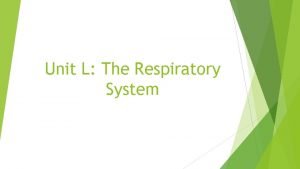THE RESPIRATORY SYSTEM The respiratory system is the




- Slides: 4

THE RESPIRATORY SYSTEM • • The respiratory system is the organ system that provides oxygen to the cells and removes carbon dioxide from the body. This system works closely with the circulatory system. Review the following diagram to locate the components of the human respiratory system: – nasal cavity – mouth – trachea – bronchi – lungs – diaphragm 3. 6 respiratory system

THE RESPIRATORY SYSTEM 3. 6 • Air travels through the trachea to the lungs. The trachea contains many epithelial cells that have hairlike projections called cilia. Cilia help filter out and remove foreign materials (such as dust) that might otherwise enter the bronchial tubes and lungs. • The main purpose of the respiratory system is to exchange gases. Breathing brings air into and out of the lungs, so that gas exchange can occur. • Oxygen enters the bloodstream in the lungs by diffusion, and carbon dioxide leaves in the same way. This gas exchange specifically takes place in the alveoli, which are surrounded by capillary networks containing blood. • When the blood arrives at the cells, the oxygen diffuses from the blood into the cells. At the same time, carbon dioxide diffuses from the cell into the blood.

3. 6 THE RESPIRATORY SYSTEM • Air is moved in and out of the respiratory system by breathing. Air is drawn into the lungs by inhaling and is then pushed out by exhaling. • Breathing is controlled involuntarily. It is controlled by a part of the brain that detects the concentration of carbon dioxide in the blood. If the carbon dioxide level increases, the brain sends a signal to the diaphragm to speed up. This then increases the rate of breathing and causes the heart to beat faster to decrease the carbon dioxide concentration in the blood. • All animals have respiratory systems that depend on diffusion to move oxygen in and carbon dioxide out. • Fish use gills to diffuse oxygen from the water into the blood and carbon dioxide out. gills

THE RESPIRATORY SYSTEM 3. 6 • Because the respiratory system is constantly exposed to substances in the air, it can be affected by many different diseases. • Tuberculosis (TB) is an infectious disease caused by bacteria that are breathed into the lungs, where they grow. TB can be successfully treated with medicine and hospitalization. • Tobacco smoke is also a serious threat to respiratory systems because it contains carcinogens. • In 2003, a deadly new disease called severe acute respiratory syndrome (SARS) spread around the world. In Canada alone, 438 cases were identified, and 44 patients died. This chest X-ray shows evidence of TB in the upper part of the lung on the right.







